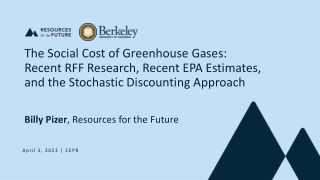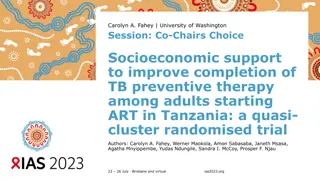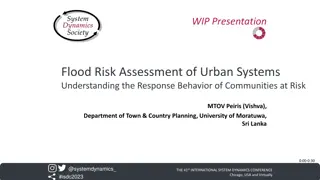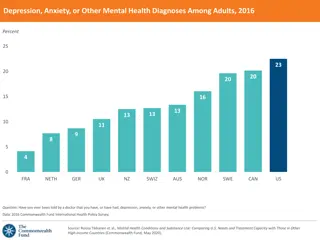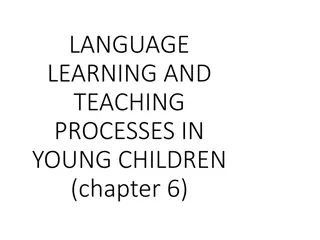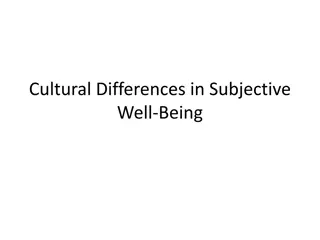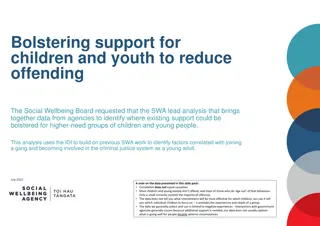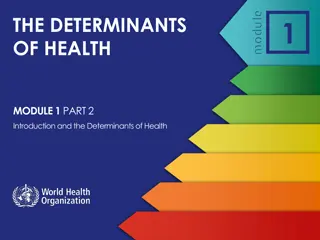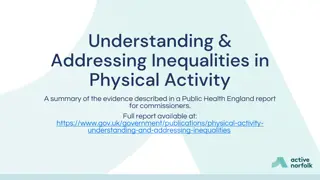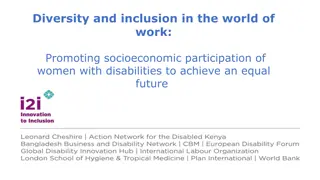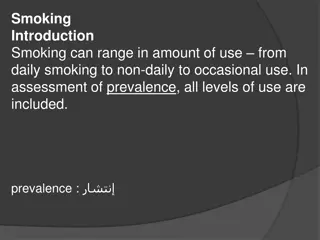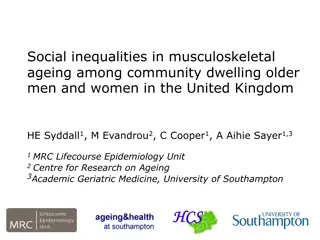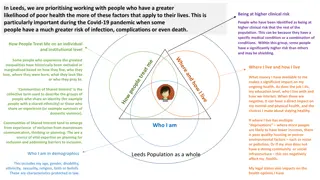Fostering Diverse Schools Demonstration Grants
Fostering Diverse Schools Demonstration Grants program, its priorities, and selection criteria in this pre-application webinar. Discover how to develop or enhance a comprehensive plan to increase socioeconomic diversity in schools and promote academic achievement.
0 views • 29 slides
Financial hardship and the economic burden of health [cancer] care
The financial hardships and economic burdens faced by individuals in cancer care, highlighting the impact of socioeconomic status and household financial insecurity. It also explores the association between financial hardship and various health outcomes.
1 views • 19 slides
Economic Framework for Greenhouse Gases: Recent Insights
A comprehensive analysis of the social cost of greenhouse gases, including recent RFF research and EPA estimates, using a stochastic discounting approach. Explore a modular framework for calculating the SCC and RFF Socioeconomic Projections on global CO2 emissions and economic growth. Learn about th
0 views • 17 slides
Climate Justice & Disadvantaged Communities: Environmental Issues in US EPA Region 2
Climate justice and the impact on disadvantaged communities are key environmental issues addressed by Adriana Espinoza, Deputy Commissioner for Equity & Justice in US EPA Region 2. The initiative identifies and prioritizes disadvantaged communities based on multiple criteria, including environmental
5 views • 18 slides
Enhancing Completion of TB Preventive Therapy with Financial Incentives
Study in Tanzania shows that financial incentives and targeted peer counseling increase completion of isoniazid preventive therapy among ART initiates. Providing short-term socioeconomic support benefits TB prevention efforts and improves outcomes for individuals with HIV. Effective strategies may i
1 views • 14 slides
Understanding Urban Flood Risk and Community Response Behavior
Flood risk assessment in urban systems involves complex interactions among natural, physical, and social elements. Factors such as population vulnerabilities, disparities in socioeconomic status, and post-disaster recovery challenges impact how communities respond to flood events. This research expl
3 views • 4 slides
Impact of Socioeconomic Factors on Childhood Development
Children's development and academic success are influenced by socioeconomic factors, as highlighted in a recent study. The research reveals disparities in access to resources and opportunities among children, impacting their educational outcomes and overall well-being. Initiatives like the Youth Edu
3 views • 43 slides
1 Year Diploma in Hotel Management Fees
The 1-year diploma in hotel management fees at Lexicon Institute of Hotel Management are sufficiently inexpensive to enable students from all socioeconomic situations to pursue post-12 affordable education. It provides two hotel management diploma programs: the Advanced Diploma in Hospitality Studie
0 views • 1 slides
Mental Health Insights Among High-Income Countries Adults in 2016
Explore the prevalence of depression, anxiety, emotional distress, and socioeconomic needs among adults in high-income countries based on the 2016 Commonwealth Fund International Health Policy Survey. The data highlights the rates of mental health diagnoses, subjective experiences of emotional distr
1 views • 10 slides
Understanding Social Determinants of Health
Chronic conditions like heart disease and cancer have multiple causes, not all biological. Social epidemiology studies the social distribution of health, morbidity, and mortality risk influenced by social status and conditions. Factors such as age, gender, race, socioeconomic status, and social cond
0 views • 32 slides
Understanding Social Class and Consumer Behavior
Explore the concept of social class and its impact on consumer behavior across different socioeconomic groups. From subjective to objective measurements, learn how lifestyle choices vary between upper class elites, high-level professionals, and the middle class. Discover how social class influences
0 views • 11 slides
Language Learning and Teaching Processes in Young Children
Development of language in young children is influenced by various factors such as their cultural and linguistic environment, unique characteristics, and interactions with adults. Optimal language development requires language stimulation from the environment. Varied cultural practices impact langua
1 views • 51 slides
Cultural Contrasts in Subjective Well-Being: Factors and Values
Societies exhibit varying levels of well-being influenced by factors such as wealth, stability, and culture. Economic development, social stability, and individualist-collectivist values play crucial roles. Broad socioeconomic indicators like GDP and life expectancy impact well-being significantly.
1 views • 49 slides
Understanding Trauma and Stress-Related Disorders: A Comprehensive Overview
Trauma and stress-related disorders encompass maladaptive responses to severe stress, affecting social functioning. This article delves into classifications, specifically PTSD, emphasizing clinical presentation and management. It explores ICD-10 and ICD-11 coding, defining PTSD and its essential fea
0 views • 30 slides
Analyzing Support for At-Risk Children and Youth to Reduce Offending
The Social Wellbeing Board has tasked the SWA with analyzing data to enhance support for high-need children and young people to prevent offending. Recent statistics show a significant increase in youth crime in Auckland, potentially linked to COVID-19 impacts. Prior research highlights factors like
0 views • 8 slides
Understanding the Determinants of Health: Exploring Factors Influencing Well-being
Explore the intricate web of factors affecting health and well-being, from socioeconomic and environmental influences to genetic predispositions. Learn about the social determinants of health and their impact on individual and population well-being. Gain insights into why framing health in societal
0 views • 16 slides
Comparing 1750 to 1900: Population Growth in Britain
The population of Britain saw a significant increase between 1750 and 1900. In 1750, the population was 7 million, and by 1900, it had grown to 37 million. This represented an 87% increase. The number of people living in towns also rose from 13% to a higher percentage. Factors contributing to this g
0 views • 6 slides
Addressing Inequalities in Physical Activity: Summary of Evidence
This report highlights research by the University of Derby on inequalities in physical activity among different demographic groups. Findings show disparities in PA levels that require immediate action to address. Health is influenced by various factors, including genetics, lifestyle, environment, ac
0 views • 19 slides
Promoting Socioeconomic Participation of Women with Disabilities for an Equal Future
In the world of work, diversity and inclusion play crucial roles in promoting socioeconomic participation of women with disabilities to achieve an equal future. This webinar focuses on understanding the gender dynamics, power relations, and barriers faced by women and men with disabilities in econom
0 views • 20 slides
Understanding Social Gradients in Health and Socioeconomic Status
This presentation delves into the complexities of social gradients in health and socioeconomic status, highlighting the impact of indicators such as employment status, education, poverty, and housing tenure. It emphasizes the need to reassess indicators used for determining socioeconomic status and
2 views • 7 slides
Impacts of Work-Based Learning on Vulnerable Youth in Vocational Education
Work-based learning (WBL) is recognized as a catalyst for change in vocational education for vulnerable youth, providing them with a second chance and breaking barriers to access opportunities. WBL, including work experience, virtual experiences, and industry connections, serves as a protective fact
1 views • 14 slides
Understanding MSK Patient Pathways: Barriers and Solutions
The project aims to explore factors influencing trends in hip replacements and outpatient appointments, focusing on patients from different socioeconomic backgrounds. It involves in-depth analysis, interviews, and engagement with various stakeholders to understand patient pathways and improve servic
0 views • 15 slides
Capital Area Healthy Start Coalition Needs Assessment Presentation
The Capital Area Healthy Start Coalition, established as part of the Florida Healthy Start Initiative, is conducting a needs assessment to identify issues affecting maternal and child health outcomes in the community. The assessment aims to determine high-risk populations and prioritize groups for i
0 views • 45 slides
Understanding the Unequal Impact of Inflation on Different Socioeconomic Groups
Inflation affects different households unevenly, with poorer households experiencing faster price growth due to various factors like innovation and expenditure capabilities. The distributional effects are further influenced by economic recovery, leading to implications on real hourly wage growth and
0 views • 5 slides
Ecological Factors and Climatic Influences on Plant Life
Ecological factors play a crucial role in shaping the environment for organisms to thrive. This includes living (biotic) and non-living (abiotic) components like climatic factors, edaphic factors, topographic factors, and biotic factors. Climatic factors such as light, temperature, water, wind, and
0 views • 14 slides
Examining Socioeconomic Status of Childcare Workers in Illinois
Childcare workers in Illinois earn a median hourly wage of $10.5, ranking 35th in hourly wages among 730 occupations. The study aims to understand the flexibility and demographics of childcare workers compared to other occupations with similar wages. Assumptions suggest childcare work is predominant
0 views • 11 slides
Impact of Socioeconomic Conditions on Drug Use Disorders: Insights from World Drug Report 2020
The World Drug Report 2020 highlights the strong correlation between socioeconomic factors and drug use disorders. Studies reveal that communities facing poverty, violence, and social inequality are at a higher risk of drug overdoses and addiction. Factors like income inequality, lack of social capi
1 views • 17 slides
Integrating Climate Change Education into Responsible Management Education
Explore how Nottingham Trent University is incorporating climate change education into responsible management education, focusing on the success of the Carbon Literacy Training in Coronation Street. The research project delves into the background, research questions, achievements, and insights behin
0 views • 22 slides
Understanding Peptic Ulcers: Causes, Prevalence, and Treatment
Peptic ulcers are circumscribed ulcerations in the gastrointestinal mucosa, commonly caused by Helicobacter pylori infection. They have a higher prevalence in developing countries and are associated with factors like socioeconomic status, poor hygiene, and genetic links. While peptic ulcers naturall
0 views • 54 slides
Impacts of Solar Energy on Women's Socioeconomic Status: Case Study in Gurei Residential Area
Globally, women face challenges due to lack of access to modern energy, impacting their socioeconomic status. This research in Gurei, South Sudan, aims to assess the effects of solar energy on women's lives, addressing issues of clean energy access, cultural barriers, and women's involvement in the
0 views • 7 slides
Understanding Factors and Prime Factors in Mathematics
Explore the concept of factors and prime factors through practical scenarios involving Jedward, stationary supplies, and school choirs. Learn how to find factors of numbers like 18 and 30, identify prime numbers, write numbers as products of prime factors, determine common factors, and calculate low
0 views • 19 slides
Socioeconomic Transformations and the Legacy of the Paraguayan War (1864-70) in Brazil
The content delves into the turbulent times of the Paraguayan War and its aftermath in Brazil during the 1860s. It explores the socioeconomic changes, political dynamics, and demographic shifts that shaped the era, highlighting the impact of the war on Paraguay and the region. The narrative unfolds
0 views • 12 slides
Understanding Travel Demand Models in Transportation Planning
Travel Demand Models play a crucial role in transportation planning by mathematically describing relationships among transportation systems and socioeconomic factors. This lesson provides an overview of travel demand modeling, including basic elements of a model, modeling steps, and advanced topics
0 views • 28 slides
The Impact of Smoking on Public Health in the UK
Smoking, ranging from daily to occasional use, remains a significant public health concern in the UK. Despite declining rates, tobacco use still causes thousands of premature deaths annually. Various factors such as socioeconomic status and gender influence smoking prevalence. The Department's tobac
0 views • 23 slides
Optimised Methods for Collecting Socioeconomic Information in the Pacific Region
This presentation explores the optimised methods used in the Republic of the Marshall Islands Household Income and Expenditure Survey (RMI HIES) to collect socioeconomic data. It covers the objectives and history of HIES in the Pacific, the standardised methodology implemented since 2012, and detail
0 views • 57 slides
Social Inequalities in Musculoskeletal Ageing Among UK Older Adults
Musculoskeletal disorders pose a significant burden on healthcare in the UK, particularly among older individuals. This study aims to explore social inequalities in musculoskeletal ageing among community-dwelling older men and women aged 59-73. Utilizing data from the Hertfordshire Cohort Study, fac
0 views • 19 slides
Cross-National & Cross-Cultural Risk Factors for Offending
Explore key risk factors for offending across nations & cultures, analyzing homicide rates, structural differences, individual/family factors, and the generalizability of crime risk factors. Learn about findings related to impulsivity, achievement, conduct problems, family supervision, parenting sty
0 views • 13 slides
Approaches to Health Disparities in Anthropology: Quantitative vs. Qualitative Methods
Exploring health in anthropology involves various factors like social, cultural, biological, and linguistic influences. This content delves into the quantitative research on disparities in health insurance coverage, particularly focusing on Latino vs. white respondents in Texas. The study utilized l
0 views • 13 slides
Understanding Health Inequalities and Communities of Shared Interest in Leeds
In Leeds, a focus is placed on addressing health inequalities by working with individuals who are at higher risk due to various factors impacting their lives. These factors include medical conditions, socioeconomic status, living conditions, and more, which can greatly influence overall health outco
0 views • 4 slides
Conditional on the Environment? The Contextual Embeddedness of Age, Health, and Socioeconomic Status as Predictors of Remote Work among Older Europeans through the COVID-19 Pandemic
This study delves into how the COVID-19 pandemic has influenced remote work patterns among older Europeans, focusing on the interaction between age, health, socioeconomic status, and contextual factors. It explores the impact of government restrictions, education, income, age, and health on the abil
0 views • 24 slides

![Financial hardship and the economic burden of health [cancer] care](/thumb/779/financial-hardship-and-the-economic-burden-of-health-cancer-care.jpg)
